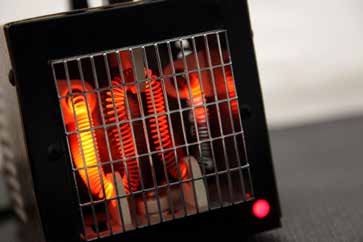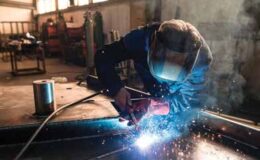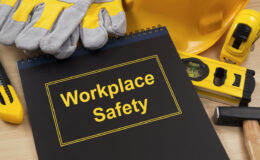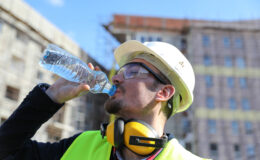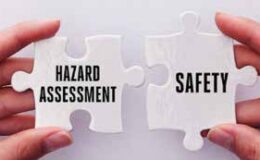By Travis Halsted, ARM, COSS
Well, as much as we tried to avoid it, our warmer temperatures are slipping away. As we all awake to cooler mornings, furnaces throughout Michigan are starting up. Regardless of the industry that you are in, so are the heating devices at yours. Whether it be by gas, electric or propane, whenever there is a heat source there is a hazard of fire. Workers’ Compensation Loss Control often focuses on how to reduce lacerations, strains, contusions and fractures to name a few. Life safety items are often touched on, but not a point of focus as catastrophic events are less frequent. Even the smallest fire could result in respiratory distress, burns, and even fatality claims. It is vital that loss control looks at all aspects, and because of this, I wanted to point out some tips on how to prevent potential fires from heating devices in your workplace.
Furnaces
My inspections of factories, warehouses and even some storefronts, provide me with a look at furnaces of many different kinds. Furnaces can be found in utility closets, hanging from the ceiling, mounted on the wall, and numerous other places in any facility. During the warmer months, these heating devices are often covered up with the stacking of products. They are often neglected and even hit by product/fork lifts. Even before a furnace is started, each furnace should be inspected for damage. This includes the furnace, gas lines leading to the furnace and even the device that controls the furnaces. Furthermore, check the area around your furnace. Many furnace fires are the result of flammable objects and substances near the furnace. Keep paper, trash, paint, and other flammable material far away from your furnace.
Here are some additional safety tips for your furnaces:
- If you smell gas, turn off the gas at the main valve, don’t ignite anything (including turning on or off lights and electrical devices), and leave the area immediately. Call the fire department or local gas company from a cell phone or neighbor’s house.
- Check the walls and ceiling around your furnace. If there is soot or discoloration, call a professional to inspect your ventilation.
- Check your furnace filter every 30 days and wait no longer than 90 days to clean or replace it if applicable. This will also improve your airflow and furnace efficiency.
Space Heaters
I often find space heaters being used during my winter safety inspections. While walking around I hear the familiar buzz of the fan from the heater inside an employee’s office. Space heaters provide employees with the ability to adjust their own temperature, but they also provide a plethora of hazards.
Space heaters account for about one-third of all winter house fires and 80 percent of all winter heating fire deaths (Boxley, 2014). While these numbers are for residential domiciles, the same type of fires can happen at your facilities. In most of the offices that I find these space heaters running, there is not an employee present. In an attempt to make employees comfortable, companies will allow the space heaters, and that’s ok. It’s just vital that we remember these safety tips if space heaters will be allowed in your facility.
- Require employees to obtain approval from a supervisor or facility manager.
- Ensure the device is certified by an independent testing laboratory. Tip over protection (auto shut off) is something that should be on every space heater used in your facility.
- Position the heater at least 3 feet away from flammable materials such as papers, clothing and rugs.
- Keep heaters out of high-traffic areas, such as doorways, where they can be a tripping hazard.
- Don’t use extension cords or power strips, as these can overheat and start a fire. Instead, plug the device directly into a wall outlet. Refrain from plugging additional devices into the same outlet as the space heater.
- Never leave the heater unattended while in operation. At the end of the workday, unplug the space heater.
Other Items
So the furnaces are taken care of. You have looked at all of the space heaters that employees are using and found them to be in good and safe working condition. Now you are wondering what else you can do to protect your employees in the event of a fire. How proactive of you! I have a couple more items that can assist you in being prepared.
- Inspect fire extinguishers monthly. Ensure that your fire extinguishers are free of any obstructions and that nothing is blocking or limiting the ability to reach them. You will want to check the gauges to verify that the pressure is not too high or too low. An inspection of the can, hoses and nozzles to verify that they are not damaged, rusted or dented. Furthermore, you want to make sure that any dust, oil, grease or other debris is cleaned from the extinguisher. Finally, you want to train your employees on how to use a fire extinguisher. Most people have never used an extinguisher in an emergency situation, and the training would give them the skills to be able to do so.
- Develop and Implement an Emergency Action Plan. This plan will cover evacuation routes, assembly locations, management responsibilities and where the vital utilities are for arriving first responders. All employees should be trained on this procedure and running a drill would provide you with a look at any deficiencies in your program. A sample Emergency Action Plan can be found on the MTMIC Client Portal.
- Finally, make sure you have smoke and CO alarms installed throughout your facility. This is especially important in your office setting and by furnaces. Fire safety is truly a matter of life and death. It is essential that we access, implement and audit controls to reduce the likelihood of a fire. The MTMIC Client Portal has fire safety training items, an Emergency Action Plan program template, and safety videos available for your use. If you have any questions about fire safety, please reach out to your Loss Control Consultant.

